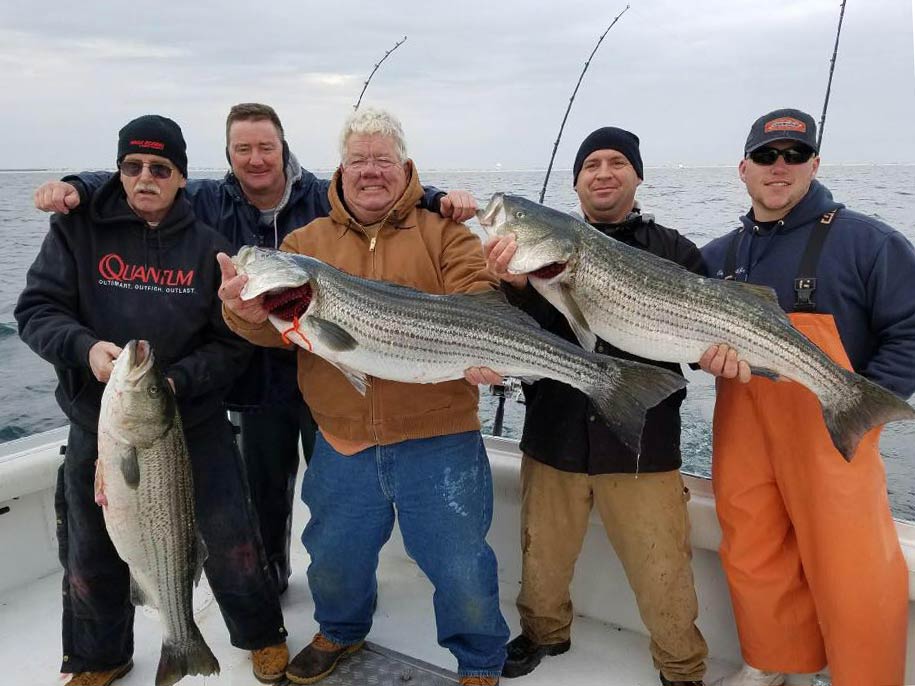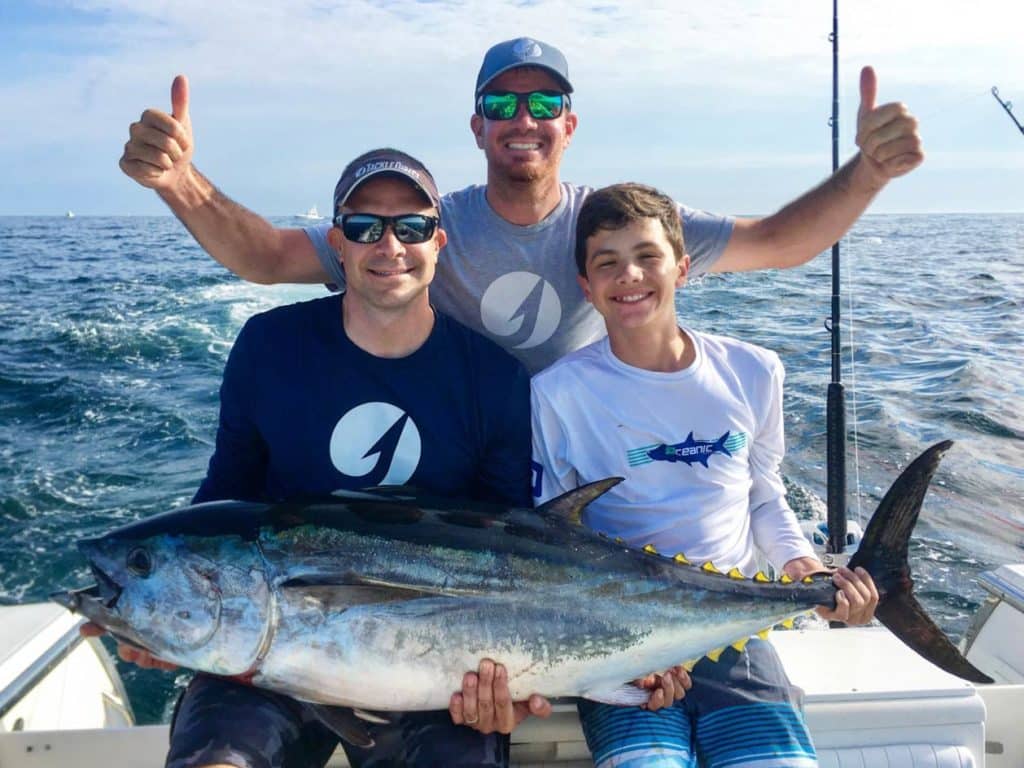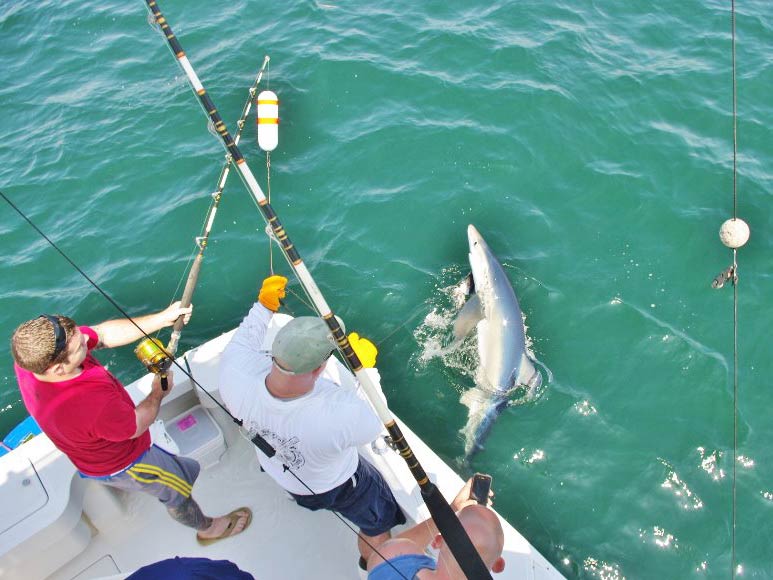Cape May is located at the southernmost tip of New Jersey and is America’s oldest seaside resort. It offers the perfect mixture of historic charm and authentic beauty. You can enjoy an early-morning stroll before spending your day on the beach. Or enjoy some whale watching from March to December. There’s also, however, something for us anglers too. Fishing in Cape May is absolutely world-class.

First of all, Cape May is among the most prolific Striped Bass fisheries in the country. You can get to sheltered sounds within a mile of shore and then head to Cape May inlet, before eventually venturing out into the deep waters of the Atlantic. Alternatively, anglers can explore the shallows of Delaware Bay and everything Cape May Canal has to offer.
In this guide, we’ll talk about the best fish species you can target everywhere from Delaware Bay in the west to the Atlantic Ocean in the east. We’ll also cover the best spots, seasonality, and fishing techniques. So, on that note, let’s dive in.
What can I catch fishing in Cape May?

Wherever you set foot in Cape May – be it a jetty, a spot along the shoreline, or out on the high seas – you can get your hands on a large variety of fish species. Your potential catch depends on the season and where exactly you’ll be fishing.
If you stick to the inshore waters, you can expect anything from high-class Striped Bass and Bluefish to Tautog and Weakfish. In the Atlantic, your list of catches may include Tuna, Mahi Mahi, and even Marlin and Sharks. So let’s see what exactly you can find, and where.
Delaware Bay and Inshore
Blackfish (Tautog)

Also known as Tautog, Blackfish are among the popular catches in Cape May. They aren’t only fun to catch, but also make good table fare. You may want to pay attention to the open seasons and NJ size and possession limits while targeting Blackfish. 15 inches is the minimum length, while the possession limit varies depending on the season.
Where’s the best spot to target the fish? Most local anglers recommend fishing near the reefs. Blackfish are normally active during the summer months. However, as they migrate quite often, you can try your hand at Blackfishing in winter, too.
Weakfish

Fishing for Weakfish in Cape May is pretty exciting. Both local and visiting anglers especially enjoy targeting Weakfish thanks to their beauty. In fact, you can do it anytime from May until August – but there’s no closed season.
If you’re looking to target Weakfish, book an early morning charter. This is the best time to try your hand at fishing for Weakfish in Cape May, although you might still find them in the early afternoon. Make sure to let your charter captain know you want to go after them, though, so that they can tailor-make your trip.
The minimum size of Tautog is 13 inches, while the possession limit is one fish per angler.
Striped Bass

Striped Bass fishing in Cape May is a year-round pleasure, although August through October is the best time of year. During the fall, Stripers target schooling bait, so you’ll most likely want to strike then. While many other fish head to warmer waters, Striped Bass don’t mind when it gets cold.
You can keep one Striped Bass within a size limit of 28–38 inches. The open seasons vary depending on where you’re planning to fish. Keep in mind, though, that you’re only allowed to fish within 3 nautical miles from shore in the Atlantic Ocean.
Bluefish

Come July, anglers pack their rods and hit the bays in search of Bluefish. These beautiful fish bite less as the water cools down, although you can still enjoy some action in the fall. Bluefish actively feed from July through October. But, as with Weakfish, there’s no closed season!
There’s also currently no size limit. You can keep five fish per person if you’re fishing with a party/charter, and three if you’re a solo angler.
Atlantic Ocean
Tuna

Bluefin, Yellowfin, and Bigeye Tuna are among the potential catches for offshore anglers in Cape May. That means that Tuna enthusiasts have the opportunity to catch some fish any time of the year!
If you’re after Yellowfin, head out anytime from May through September. June and July are best for both Bluefin and Bigeye, while you can also target Bluefin in October.
When it comes to size and possession limits, you can keep three Yellowfins of a 27″ curved fork length per person, while limits for Bluefin change depending on the season. You can keep as many Bigeye as you catch, as long as they’re of a 27″ curved fork length.
Local captains know the best spots and techniques for Tuna, so it’s never a bad idea to book a trip with a local crew. They can take you to canyons and offshore dropoffs, where the possibility to spot these underwater monsters increases.
Marlin

When it comes to Marlin fishing in Cape May, White and Blue are both on the menu. These ferocious fighters are popular catches throughout the offshore waters, especially during summer and fall. Both Blue and White Marlin bite best from July through September, but you’re welcome to look for them any time of the year.
There are no possession limits, however, catch-and-release is always encouraged when fishing for Marlin in Cape May. If you want to keep one anyway, let your captain know in advance and check the regulations.
Sharks

Shark fishing aficionados won’t be disappointed by what Cape May has to offer! Throughout the year, you can hit the Atlantic Ocean and head offshore to look for Sharks such as Hammerhead and Mako.
Mako bite best during spring and then from October to November. Generally, summer is a great time of the year to catch Sharks. The most important thing is making sure to go to the ocean waters.
Just like other species, Sharks are heavily regulated. Catch-and-release is a common practice while fishing for these toothy monsters. However, you can take a look at the Federal size and possession limits if you want to keep a non-prohibited Shark.
Swordfish

Finally, our list won’t be complete without one of the most iconic deep sea fish. The elusive Swordfish is also among the potential catches on a Cape May deep sea fishing trip. You can battle these monsters during the summer months or early fall.
Local captains usually offer separate deep-dropping packages for Swordfish, along with nighttime charters. Normally, you’d release all Swordfish caught. That is if you manage to catch one!
Where to go fishing in Cape May?
When picking where to go fishing, the dilemma is simple: stay in the bay or head to the ocean? The inshore waters are full of bars and shoals for you to explore. If you decide to leave the Inlet, you can venture up to 100 miles offshore to look for big game species.

Here are our top picks for the best fishing spots in Cape May:
- Brandywine Shoals. If you’re after Weakfish, the Brandywine Shoals in Delaware Bay is the place to go. In fact, you can also add Bluefish to the mix or explore some of the deeper wrecks and catch Blackfish.
- Canyons. While you can enjoy big game fishing 20 miles from shore, the best action is 80+ miles offshore. From Cape May, you have access to productive canyons, such as Baltimore, Poor Man’s, and Wilmington out on the continental shelf.
- Cape May Rips. The Cape May Rips are a series of sandbars along the entrance to the bay, running from Cape May to Cape Henlopen. Here, the water pours in and out and toss baitfish. This, in turn, attracts Striped Bass. Everyone wins!
- Five Fathoms Bank. If you happen to fish in the area known as the Five Fathoms Bank during the height of summer, you may find some pretty impressive trophies. Bluefish and Tuna hang out here, along with various Sharks.
- Jarvis Sound. For some great inshore action, head to Jarvis Sound. It’s not too far from town, but the fishing is far from mediocre. When the tide’s right, big schools of bait attract all sorts of fish to local creeks and mud flats.
When to go fishing in Cape May?
Now that you know what you’d like to catch and where you could go, you might wonder when’s the best time to book a fishing trip. In this section, we’ll talk about such aspects as seasonality, time of the day, and tides.
Seasons

Winter might not be the most productive fishing season in Cape May, but it can still offer decent catches. You may want to stick to the inshore waters and look for Striped Bass, Blackfish, Bluefish, or go Crabbing.
Come spring, Shark fishing picks up offshore in March, while Tuna begin to bite in May, marking the beginning of the sportfishing season. Note that Blackfish are usually closed for harvesting in March, but the spring closure ends in April.
Summer is the overall best time to go fishing in Cape May. Various tournaments take place in June and July, including the South Jersey Shark and the Canyon Club Overnight Tuna events, along with Stone Harbor Marlin Tournament and the family-friendly South Jersey Offshore Showdown. The most popular fishing event, though, the MidAtlantic, takes place in August.
The action doesn’t end with summer, though. During the fall months, you can fish for various game fish in Delaware Bay or hunt for Marlin, Tuna, and Mahi Mahi offshore. Inshore, you can fish for Blackfish all the way into November.
Time of Day

Anglers can enjoy Cape May fishing in the morning, afternoon, or evening. Some hardcore enthusiasts may even fish at night, depending on what fish species they’re after.
In general, the best time of the day depends on the season. If you’re fishing in summer, consider heading out early in the morning when the waters are still cooler. Many fish species feed in the morning, but not all of them. As you already know, Bluefish bite better in the evening. Afternoons are more productive in spring, fall, and winter.
Tides
It’s not a surprise that fishing often depends on tide times. As the water begins to rise during incoming tides, fishing tends to be much more productive. However, you should always tailor your trip according to your targeted species. Fishing for Weakfish, for instance, is better during high tides.
How to go fishing in Cape May?

With such a rich variety of potential targets, Cape May captains use a range of fishing techniques. For example, drifting is the most popular method to land Striped Bass, especially if you drift baits over the rips at the mouth of the bay. Late evening or nighttime Weakfishing usually includes casting jigs with plastic worms or crabs.
Cape May Tuna anglers practice trolling around various canyons, although you may also throw jigs or poppers to mix it up. When targeting Sharks, local captains stick to throwing bait and using circle hooks and wire leaders.
If you’re a shore angler, you might already know that Cape May is famous for its beaches. Surf fishing for Bass is a popular activity among both locals and visiting anglers.
The best option to get to know the Cape May fishing scene is to book a trip with a local captain. It doesn’t matter if you fish in the bay or the Atlantic, there are various guides that cater to all sorts of anglers and work throughout the year.
F.A.Qs
Do I need a fishing license?
- There’s no general saltwater license in New Jersey. However, there are a few things you need to know before hitting the waters. As a solo angler, you need to register with the New Jersey Saltwater Recreational Registry Program and follow all the regulations. If you’re fishing with a charter, your captain will take care of your registration.
Do I need a special permit to fish for Sharks, Tuna, and Billfish?
- There are certain HMS (Highly Migratory Species) permits you need to obtain when targeting these species in federal waters.
What else can I do in Cape May besides fishing?
- If you or someone in your party is interested in other water activities, you can try jet skiing, paddling, kayaking, or even go sightseeing aboard a catamaran. Salt marsh safaris are a popular way to explore Cape May’s nature, as well as whale watching tours and bay cruises.
Fishing in Cape May – The Bay, Ocean, and Beyond!

There aren’t many places in the world where you can target Weakfish and Striped Bass one day and then Tuna and Swordfish the next. South Jersey’s coast is full of options, and Cape May is no exception. Here, everything is possible, and the waters are simply inviting you to fish. Try fishing in Cape May at least once, and you might get hooked forever!
Have you ever been fishing in Cape May? What are your best catches? Do you prefer fishing in the bay or in the ocean? Let us know in the comments below!
The post Cape May Fishing: The Complete Guide appeared first on FishingBooker Blog.
https://ift.tt/b8yipWl
0 Comments
Enregistrer un commentaire